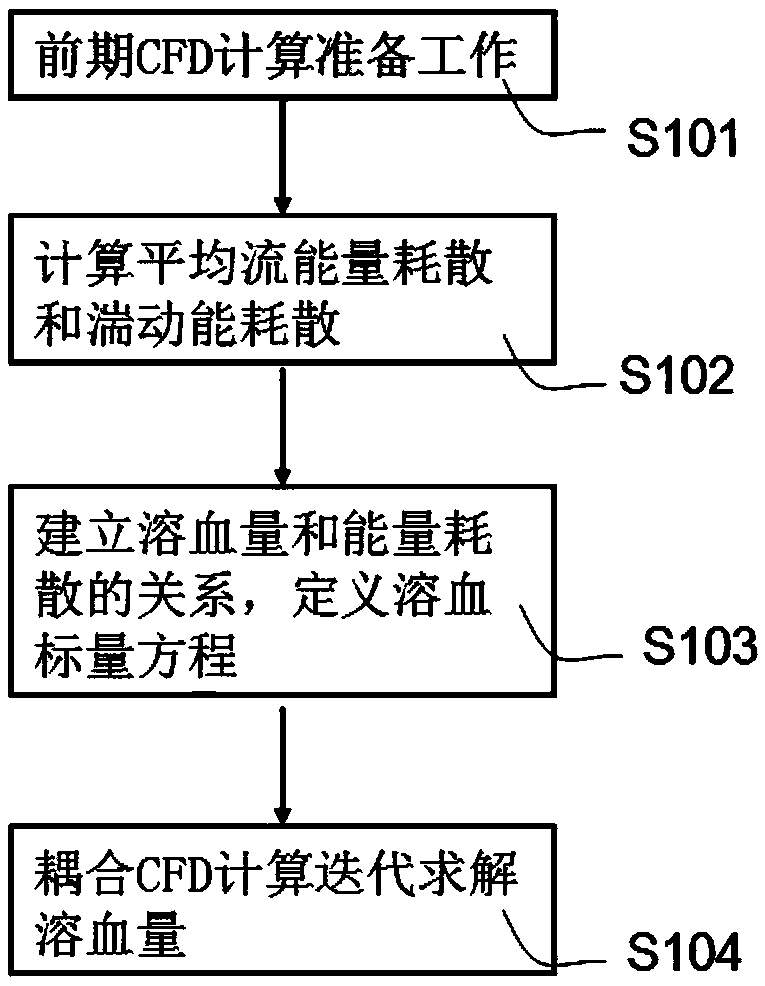Hemolysis experience predicting method and device based on energy dissipation
A technology for energy dissipation and prediction devices, which is applied in the field of biomedical engineering artificial organs, and can solve problems such as quantitative relationship blanks
- Summary
- Abstract
- Description
- Claims
- Application Information
AI Technical Summary
Problems solved by technology
Method used
Image
Examples
Embodiment 1
[0088] An empirical prediction method for hemolysis based on energy dissipation of the present invention, the process is as follows figure 1 shown. This example takes the hemolysis calculation of a capillary channel as an example to illustrate the specific implementation steps.
[0089] S101: preparatory work for CFD calculation;
[0090] The capillary calculated in this example is as figure 2 shown. Hemolysis tests of this pipeline were performed by Kameneva et al. in 2004 with Reynolds numbers ranging from 300-5100. This method mainly improves the prediction of hemolysis in turbulent flow, so here only four conditions of transition and turbulent flow are considered, and the Reynolds numbers are 2230, 3500, 4500 and 5100, respectively, as shown in Table 1. The values in the fourth column are the amount of hemolysis measured by Kameneva's people.
[0091] Table 1. Four working conditions of capillary simulation calculation
[0092]
[0093]
[0...
Embodiment 2
[0129] This example takes the ideal medical device benchmark calculation example of FDA (Food and Drug Administration, US Food and Drug Administration) as an example to illustrate the specific implementation steps. FDA designed this example to evaluate the accuracy of CFD simulation techniques and hemolysis prediction methods. The FDA organized the flow field and hemolysis measurements for this example. The working conditions of the flow field measurement cover laminar flow, transitional flow and turbulent flow. The hemolysis test uses bovine blood, and the hematocrit is about 36%. FDA ideal medical devices such as Figure 5 As shown, its main features are the sudden constriction section and the conical diffuser.
[0130] S101: preparatory work for CFD calculation;
[0131] In this embodiment, only turbulent flow conditions are considered, and the flow rates are 4.1 liters / min and 5.1 liters / min, respectively, as shown in Table 4. The value in the fifth column is th...
Embodiment 3
[0142] This example focuses on the application of the hemolysis prediction method of the present invention in the research and development of actual medical devices and the design of blood compatibility, taking the FDA blood pump benchmark example as an example.
[0143] Cardiovascular disease is a leading cause of disability and premature death worldwide. The emergence of ventricular assist device (VAD, commonly known as artificial heart or blood pump) has brought hope to solve this problem. So far, the third-generation blood pump has entered clinical application, and blood pumps have successfully survived tens of thousands of patients with end-stage heart failure in developed countries such as Europe and the United States. However, the hemocompatibility complications caused by VAD have not been properly resolved so far.
[0144] The purpose of the FDA blood pump benchmark study is to evaluate and promote the application of CFD and hemolysis prediction methods in blood...
PUM
 Login to View More
Login to View More Abstract
Description
Claims
Application Information
 Login to View More
Login to View More - R&D
- Intellectual Property
- Life Sciences
- Materials
- Tech Scout
- Unparalleled Data Quality
- Higher Quality Content
- 60% Fewer Hallucinations
Browse by: Latest US Patents, China's latest patents, Technical Efficacy Thesaurus, Application Domain, Technology Topic, Popular Technical Reports.
© 2025 PatSnap. All rights reserved.Legal|Privacy policy|Modern Slavery Act Transparency Statement|Sitemap|About US| Contact US: help@patsnap.com



